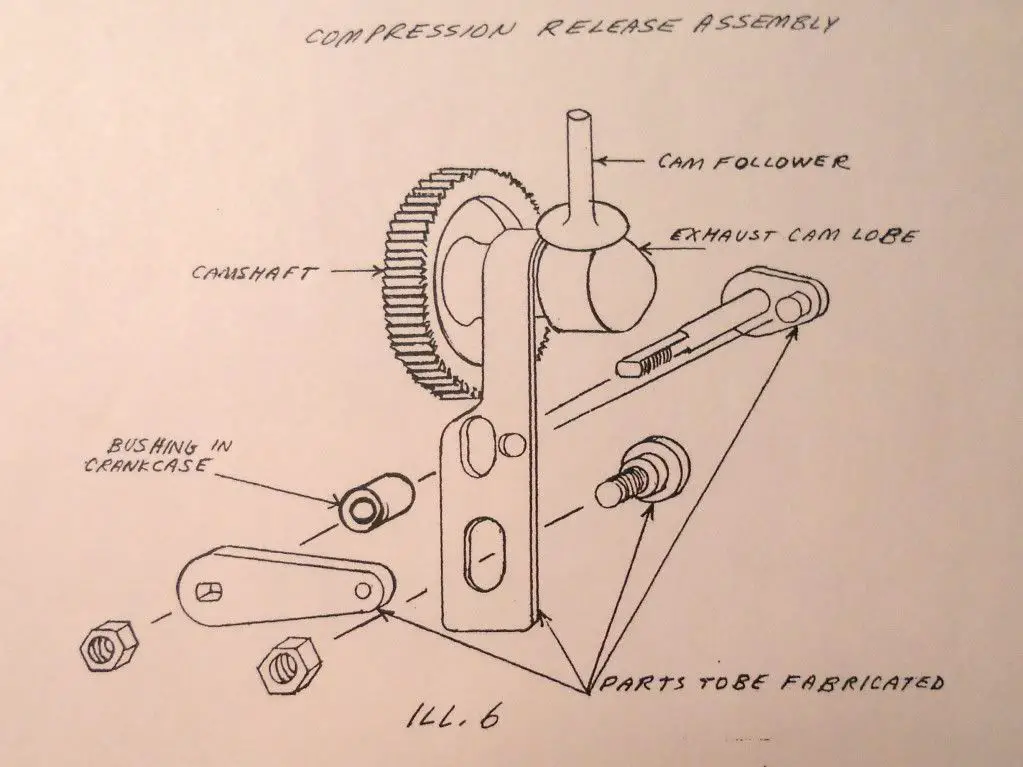You are using an out of date browser. It may not display this or other websites correctly.
You should upgrade or use an alternative browser.
You should upgrade or use an alternative browser.
Briggs & Stratton Compression Release
- Thread starter msrfan
- Start date
I put the cam in a lathe and turn the area between the exhaust lobe and the gear to 1/2inch diameter. It takes very little off and gets rid of the rough casting. Trying to pedal start without a comp. release is very hard with a slipper clutch and impossible with an autoclutch.
charliechaindrive.
New Member
? I don't follow but couldent a person just put a petcock on the sde of the crankcase and open it to relase and when it strt just reach down and close?
Goldy
Member
Charlie, you would have to put the cock on the cylinder head rather than the crankcase and turning it on and off by hand while pedaling would be a bit of a pain the the butt. This is the set up I used on the Flying Merkel and it works VERY well. If I get the time I want to use it on the BSA as well, Thanks again msrfan!
charliechaindrive.
New Member
Alright. On the merkel tribute I'm helping choppercrazy build we're going to use belt drive. And usng the coaster brake from the stock rear wheel.
motorhedfred
Member
The concept has always been a little blurry for me too. Is the idea to let the engine turn more freely so the RPMs come up before trying to start it ? I know the newer pull start engines like the Honda GX series and clones use this....the first few years of production the Yamaha XS650 used it too.
MHF
MHF
MEASURE TWICE
Well-Known Member
The Mercury outboards do have compression release. I saw on a 5hp and I think it is automatic, like when up to speed at starting centrifugal force shuts off the compression release and with electronic ignition new outboards are less a problem starting.
Measure Twice
Measure Twice
Goldy
Member
The compression release is exactly as motorhedfred said. It's there to make it easier to initially roll over the engine by releasing pressure that would be built up during the compression stroke. Once there is some kinetic energy stored up in the flywheel you can release it and start the engine much easier. Most of the smaller B&S engines get around this (partly) by having an odd little bump on the intake cam that releases a bit of compression while the piston is at the beginning of the compression stroke, it works by lifting the intake valve a few thousandths of an inch off its seat...I have always thought that this probably reduces power to some degree. Some other small engines use a small pin that lifts one of the valves until centrifugal force takes over and lets the valve close as it should. Of course, these are supposed to be 'automatic' making the engine more user friendly for the mechanically challenged. On many of the really old magneto ignition motorcycles, they were also used to shut down the engine; I can tell you for sure, that I would have a lot harder time starting and stopping my '48 ES2 without that little trigger on the handlebar.
wayne z
Active Member
Another good thing about a comp release is that you can use it like a "jakebrake" to maximize engine braking. I do it all the time at all speeds on my Solex bike to slow down quickly without using the coaster brake so hard.
Really handy on steep downhill twisties too.
I like the funky sound it makes too.
Really handy on steep downhill twisties too.
I like the funky sound it makes too.
Last edited:
charliechaindrive.
New Member
Uh, how exactialy do you engage it?
Uh, how exactialy do you engage it?
Hey Charlie. I have a cable attached to the lever on the engine and to a handlebar lever at the other end. Pulling the handlebar lever raises the compression release lever, lifting the exhaust valve off the seat a small amount allowing easier pedalling. After getting up to speed with the pedals, release the handlebar lever and full compression is restored to the combustion chamber starting the engine. Like wayne z says, it can also assist braking when engaged. It lowers the compression enough to prevent starting, but still has enough to slow the bike down. Hope this helps your understanding of the system.
charliechaindrive.
New Member
Thanks msrfan, I'll use this and the cluch thinger that goldy used on his bsa. Now if only I can figure out how to hook THAT to a cable...
Thanks
~chaz
Thanks
~chaz


